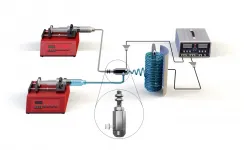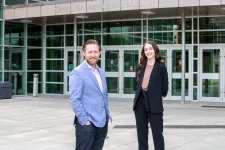(Press-News.org) Black men most likely to benefit from advanced prostate cancer therapies are 11 percent less likely to get them than non-Black men. This happens despite apparent equal opportunities in obtaining health care services, a new study in American veterans shows.
Publishing in the journal Cancer online June 29, the study showed that Black male veterans were slightly (5 percent) more likely to receive radiation or surgery for prostate cancer than non-Black men and that veterans of all races likely to benefit from such definitive therapy were also 40 percent more likely to get it compared to those who did not need it.
Led by researchers from NYU Langone Health and Perlmutter Cancer Center, the new analysis showed that, despite these broad advantages in obtaining advanced care, the Black men most likely to benefit from these treatments (i.e., those men with aggressive prostate cancer who were otherwise healthy) were 11 percent less likely to get them than non-Black men of similar age and cancer severity. And other research has documented that Black men are still three times more likely to die from the disease than non-Black patients.
"Our study suggests, for reasons that remain unclear, that Black men who need treatment may be choosing against the most beneficial prostate cancer therapies (which are often more invasive), or that such 'high- benefit' treatments, are not being offered to them as aggressively as they are to non-Black patients," says study co-investigator Joseph Ravenell, MD, associate dean for diversity affairs and inclusion at NYU Langone.
Ravenell, an associate professor at NYU Grossman School of Medicine and co-leader of community outreach and engagement at Perlmutter Cancer Center, says one possible reason for this treatment disparity is that, as past studies have found, some Black men may have greater fears than non-Black patients about side effects of aggressive therapy, such as the risk of incontinence and erectile dysfunction. These fears, he says, and other underlying reasons related to their expectations of treatment should be discussed directly with Black patients when treatment options are being considered.
"Our findings strongly indicate that patients and physicians should discuss fears, values, and preferences when considering all of the relevant treatment options for prostate cancer," says study senior investigator and urologic surgeon Danil Makarov, MD, MHS.
"Despite great strides in prostate cancer care over the past few decades, racial disparities in care persist, and there remains a lot to be done to better understand why this is happening and what we can do to finally close the gap," says Makarov, an associate professor in the Departments of Urology and Population Health at NYU Grossman School of Medicine.
"At the end of day, our goal is to offer patients the most appropriate cancer care they need, using a culturally sensitive approach," says Makarov, also a member of the Perlmutter Cancer Center, whose team is examining interventions such as counseling Black men on their risks and the benefits of prostate cancer screening, which could reduce disparities in care.
The findings come from an analysis of the medical records of 35,427 men treated for early to moderate prostate cancer at U.S. Veterans' Health Administration facilities from 2011 to 2017. Most were over age 60, were married, and had no other serious health issue.
The study also confirmed earlier work that Black men are likely to be diagnosed with prostate cancer two years earlier than men of other races across all age groups. Black men are also more likely to be diagnosed with more aggressive forms of the disease than their non-Black counterparts. Makarov says more research is needed to determine if any underlying structural or cultural bias is behind this disparity.
For the study, researchers analyzed data from the Veterans Health Administration's (VHA) Corporate Data Warehouse and Medicare. From these national databases, they identified all men diagnosed with prostate cancer and characterized them by their life expectancy (based on their other medical diagnoses) and the severity of their prostate cancer. Men in their 50s with aggressive cancer, for example, who had surgery or radiation were deemed to have received "high-benefit" treatment because it had the greatest impact on their life expectancy. By contrast, much older men with non-aggressive cancers would have been assessed as "low" benefit for aggressive prostate cancer treatments because these treatments would have had little impact on how long they lived.
Researchers focused on VHA data because it's the nation's largest provider of cancer care.
Prostate cancer remains the second-leading cause of cancer death among American men, with more than 34,000 dying annually from the disease. The U.S. National Cancer Institute estimates that 248,000 men will be diagnosed with prostate cancer in 2021, most in its earliest stages.
INFORMATION:
Funding support for the study was provided by U.S. Department of Veterans Affairs grant VA IIR15-356, the Prostate Cancer Foundation, The John and Daria Barry Precision Oncology Center of Excellence of the VA New York Harbor Healthcare System, and The Edward Blank and Sharon Cosloy-Blank Family Foundation.
Besides Ravenell and Makarov, other NYU investigators involved in the study are Shannon Ciprut, MHS; Matt Kelly, BS; Dawn Walter, MPH; Chan Wang, PhD; Aisha Langford, PhD, MPH; Herbert Lepor, MD; Daniel Becker, MD; Huilin Li, PhD; and Stacy Loeb, MD, MSc. Other study investigators are Temitope Rude, MD, at Upland Hills Health in Madison, Wis.; Angela Fagerlin, PhD, at the University of Utah in Salt Lake City; and John Leppert, MD, MS, at Stanford University in Palo Alto, Calif.
Media Inquiries:
David March
212-404-3528
david.march@nyulangone.org
A new paper in JNCI Cancer Spectrum, published by Oxford University Press, indicates that many survivors of adolescent and young adult cancers hesitate to obtain COVID-19 vaccinations.
As of March 2021, there were over 33 million cases and 580,000 deaths from COVID in the United States. Vaccines offer the best hope to control the spread of COVID-19. Some 20%-40% of the US population, however, is hesitant to obtain COVID-19 vaccination. Cancer survivors often have weakened immune systems and are more likely to develop severe respiratory infections, making them particularly vulnerable to the threat of COVID-19.
National organizations recommend strongly ...
According to the World Health Organization, about 785 million people around the world lack a clean source of drinking water. Despite the vast amount of water on Earth, most of it is seawater and freshwater accounts for only about 2.5% of the total. One of the ways to provide clean drinking water is to desalinate seawater. The Korea Institute of Civil Engineering and Building Technology (KICT) has announced the development of a stable performance electrospun nanofiber membrane to turn seawater into drinking water by membrane distillation process.
Membrane wetting is the most challenging ...
CORVALLIS, Ore. - Research by a graduate student in Oregon State University's College of Science has upended the conventional wisdom that for a century has incorrectly guided the study of a toad listed as endangered in part of its range.
Anne Devan-Song used spotlighting - shining a light in a dark spot and looking for eye reflections - to find large numbers of the eastern spadefoot toad. The study illustrates how confirmation bias - a tendency to interpret new information as ratification of existing theories - can hamper discovery and the development of better ones.
Her findings, which show that the toad spends much more time above ground than commonly believed, were published in the Journal ...
Chestnut Hill, Mass. (6/29/2021) -- A new, first-of-its-kind study led by researchers from Boston College has found that personal networks in India could play an important role in advancing the adoption of a cleaner cooking fuel, in this case liquefied petroleum gas, according to a report published in the journal Environmental Research Letters.
"This is the first report in clean cooking research to show that just like with tobacco use, obesity, or physical activity -- where our networks play a role in shaping our behaviors and decisions -- we find that personal networks are also associated with what kinds of stoves rural poor use.," said study co-author ...
The tiny mouse embryo has a heart that beats. Its muscles, blood vessels, gut and nervous system are beginning to develop. But this embryo is unusual: It was made in a lab, out of mouse embryonic stem cells, and represents the most sophisticated in vitro (in a dish) model of a mammal ever so created.
This new model, developed at the University of Virginia School of Medicine by Christine and Bernard Thisse, is a major step forward in scientists' efforts to mimic the natural development of a mammal by using stem cells. Its existence is a wonder that will help scientists understand mammalian development, battle diseases, create new drugs and, eventually, grow tissues and organs for people in need of transplants.
"We found a way to instruct aggregates of stem cells to initiate ...
Immunologists at McMaster University have discovered a previously unknown mechanism which acts like a spider web, trapping and killing pathogens such as influenza or SARS-CoV-2, the virus responsible for COVID-19.
The researchers have found that neutrophils, the most abundant white blood cells in the human body, explode when they bind to such pathogens coated in antibodies and release DNA outside of the cell, creating a sticky tangle which acts as a trap.
The findings, published online in the Proceedings of the National Academy of Science, are significant because little is understood about how antibodies neutralize viruses in the respiratory tract.
The discovery has ...
One of the key mutations seen in the 'Alpha variant' of SARS-CoV-2 - the deletion of two amino acids, H69/V70 - enables the virus to overcome chinks in its armour as it evolves, say an international team of scientists.
SARS-CoV-2 is a coronavirus, so named because spike proteins on its surface give it the appearance of a crown ('corona'). The spike proteins bind to ACE2, a protein receptor found on the surface of cells in our body. Both the spike protein and ACE2 are then cleaved, allowing genetic material from the virus to enter the host cell. The virus manipulates the host cell's machinery to allow the virus to replicate and spread.
As SARS-CoV-2 ...
A conclusive narrative review has found physical punishment of children is not effective in preventing child behavior problems or promoting positive outcomes and instead predicts increases in behavior problems and other poor outcomes over time. The study by an international group of scientists including a researcher from The University of Texas at Austin was published today in The Lancet.
Caregivers in many parts of the world use physical punishment as a response to children's perceived misbehavior: 63% of children between the ages of 2 and 4 worldwide - approximately 250 million children - are regularly subjected ...
Phase 1/2 clinical trial of CoronaVac in 550 children and adolescents aged 3-17 years in China suggests two doses of the vaccine are safe and generate a strong antibody response.
First published data on safety and immune response generated by a COVID-19 vaccine in children as young as 3-years-old supports use of CoronaVac - which was recently approved for emergency use in China among children over 3-years-old - in further studies to inform immunisation strategies.
Two doses of CoronaVac are safe and provoke a strong antibody response among children and adolescents ...
In first-of-its kind research led by a University of Massachusetts Amherst psychotherapy researcher, mental health care patients matched with therapists who had a strong track record of treating the patients' primary concerns had better results than patients who were not so matched.
In addition, this "match effect" was even more beneficial and pronounced for patients with more severe problems and for those who identified as racial or ethnic minorities.
The findings are published in JAMA Psychiatry and the Journal of Consulting and Clinical Psychology.
"One of the things we've been learning in our field ...




